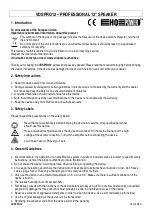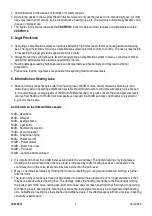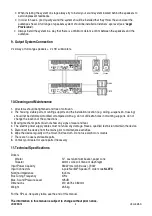
VDSPRO12
3
VELLEMAN
•
In order to relax your hearing sufficiently, the noise level should not exceed 70dB for 10 hours. Higher noise levels
during this relaxing period can prevent relaxation and promote permanent hearing damage or hearing loss.
WARNING:
Protect your ears if you want to prevent hearing damage!
7. Input and Cable Installation
a.
Inputs
•
Your speaker system is equipped with 4-pole, lockable speaker sockets. Turn the plug to the right to lock the
connection. To unlock: pull the unlock button, turn to the left and pull the plug out of the socket.
PIN
1 +
2 +
+
1 -
2 -
-
•
Unnecessarily long and thin cables will influence the damping factor and thus the low frequencies in a negative
way. In order to safeguard good sound quality, the damping factor should be around 50. The longer a cable,
the thicker it should be. Connect your speaker system via the speaker plugs.
b.
Choosing appropriate connection cables
•
Use sufficiently thick cables to connect the speaker system. Thin cables may heat up and cause significant
power loss and loss in sound quality.
•
For all speaker systems up to 400W, we recommend a cable diameter of 2.5mm²; for all other speaker cables
it's 4mm².
•
The high damping factor of your amplifier ensures a clear sound reproduction. Unnecessarily long and thin
cables will influence the damping factor and thus the low frequencies in a negative way. In order to safeguard
good sound quality, the damping factor should be around 50. The longer a cable, the thicker it should be.
•
A damping factor of 200 is reduced to 47 (8 ohms) when using a diameter of 2.5mm² speaker cable of 10m in
length. The power loss at 8 ohms is 1.63%, at 4 ohms it’s 3.25% and at 2 ohms it’s as much as 6.5%.
•
The maximum cable length is 30m!
c.
Installing the speaker cables
•
Connect the cable of the first speaker system with speaker outputs CH-1 and output CH-2 of the amplifier. The
signal will be transmitted to the individual speaker systems.
•
Always handle the cables with care and protect them from damage in transit.
•
Make sure no one can trip over the cables. Always fix them with an appropriate tape.
•
Both cables should be of the same type and length.
•
Do not loop the cables.
•
Always install the cables far away from power cables (never alongside them).
•
Never put heavy objects like speaker systems, flight cases etc. on cables.
•
Always roll cables loosely round the elbow.
8. Installation of the Speaker System
•
This speaker system should be installed at a solid, plane, anti-slip, vibration-free, oscillation-free and fire-free
location.
•
To avoid damage and fire hazard it is recommended to install the speakers out of the reach of people.
•
Before installing the system, make sure the installation area can hold a minimum point load of 5 times the
system’s load (
VDSPRO12
: 23.5kg – point load: 120kg).






















